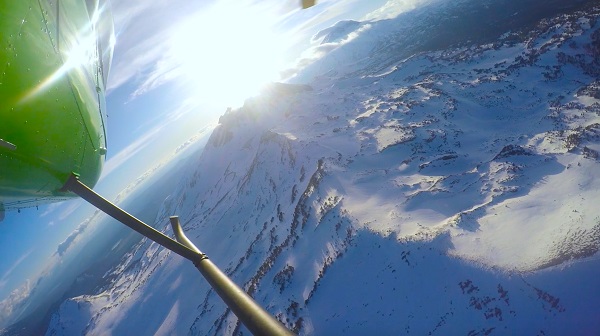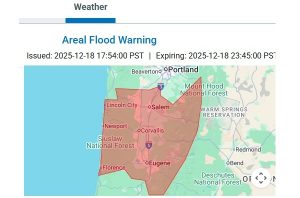Aquifer at the Cascade crest ‘like a big water tower’
4 min read
|
Getting your Trinity Audio player ready...
|
from the University of Oregon and staff reports
A team led by the University of Oregon’s Leif Karlstrom has mapped a vast aquifer at the crest of the Cascade Range.
Its active groundwater volume of 81 cubic kilometers is comparable to major continental lakes—the equivalent of about three full Lake Meads.
“That there are similar large volcanic aquifers north of the Columbia Gorge and near Mount Shasta likely make the Cascade Range the largest aquifer of its kind in the world,” Karlstrom said.
The research findings suggest “systematic controls on landscape evolution,” the team wrote, identifying volcanic landscape evolution as “a unique probe of deep coupling between Earth systems.”
Karlstrom, a UO earth scientist, led the study alongside collaborators from Oregon State University, Fort Lewis College, Duke University, the University of Wisconsin, the U.S. Forest Service and the U.S. Geological Survey. Their findings were published Jan. 13 in the Proceedings of the National Academy of Sciences.
The research is helping us understand the “Critical Zone,” the near-surface environment where atmospheric and solid earth processes interact.
The finding has already changed our understanding of volcanic hazards in the area. Magma interacting with lots of water often leads to explosive eruptions that blast ash and gas into the air, rather than eruptions with slower-moving lava flows.
The finding also has implications for the way scientists and policymakers think about water in the region — an increasingly urgent issue across the Western United States as climate change reduces snowpack, intensifies drought and strains limited resources.
Most Oregonians rely on water that originates from the Cascades. For example, the McKenzie River, which supplies most of Eugene’s drinking water, begins high in the mountains at the spring-fed Clear Lake. EWEB’s Karen Kelley told the City Club Jan. 10 that water from that mountain aquifer has been underground for seven years before it emerges at Clear Lake and makes its way down the McKenzie and into your tap.
But the discovery of this underground aquifer’s size was a surprise.
“It is a continental-size lake stored in the rocks at the top of the mountains, like a big water tower,” Karlstrom said.
Study co-author Gordon Grant is a geologist with the Forest Service. “We initially set out to better understand how the Cascade landscape has evolved over time, and how water moves through it,” he said. “But in conducting this basic research, we discovered important things that people care about: the incredible volume of water in active storage in the Cascades and also how the movement of water and the hazards posed by volcanoes are linked together.”
The western Cascades are characterized by steep slopes and deep valleys carved out by rivers. The high Cascades, meanwhile, are flatter, dotted with lakes and volcanic topography such as lava flows. The Cascade Range has been built up by volcanic activity over millions of years, making the exposed rocks in the high Cascades much younger than those in the western Cascades.
As a result, the transition zone between the western Cascades and the high Cascades around Santiam Pass is a natural laboratory for understanding how volcanoes have shaped Oregon’s landscape.
“What motivates our work is that it’s not just how these landscapes look different topographically. It’s that water moves through them in really different ways,” Karlstrom said.
To better understand the flow of water through different volcanic zones, the team took advantage of projects begun in the 1980s and ’90s. Past scientists had drilled deep into the ground and measured temperatures at different depths as part of the search for geothermal energy resources associated with hot springs.
Normally, rocks get hotter as you go deeper into the earth. But water percolating downward disrupts the temperature gradient, making rocks a kilometer deep the same temperature as rocks at the surface.
By analyzing where the temperature starts to pick up again in these deep drill holes, Karlstrom and his colleagues could infer how deeply groundwater was infiltrating through cracks in the volcanic rocks. That allowed them to map the volume of the aquifer.
Previous estimates of water availability in the Cascades took the springs at face value, measuring river and stream discharge. Instead, Karlstrom and his colleagues went deeper — literally. But since those holes weren’t originally drilled with the intent of mapping groundwater, they don’t cover every area where one might like to collect such data. So the new estimate of the size of the aquifer is a lower bound, and the actual volume might be even bigger still.
While it’s encouraging news that the aquifer is so much larger than previously believed, Karlstrom cautions that it’s still a limited resource that must be carefully stewarded and needs further study.
“It is a big, active groundwater reservoir up there right now, but its longevity and resilience to change is set by the availability of recharging waters,” he said.
The aquifer is largely replenished by snow, and snowpack in the high Cascades is expected to rapidly decrease in the coming decades. More precipitation is expected to fall as rain, which may impact the amount of recharge feeding the high Cascade aquifer. And while it’s likely resilient to small year-to-year fluctuations, many years in a row of low rainfall or no snowpack would probably be a different story.
“This region has been handed a geological gift, but we really are only beginning to understand it,” Grant said. “If we don’t have any snow, or if we have a run of bad winters where we don’t get any rain, what’s that going to mean? Those are the key questions we’re now having to focus on.”
The research was supported by the National Science Foundation and the U.S. Forest Service.
Image courtesy Patric Douglas – Own work, CC BY-SA 4.0.




